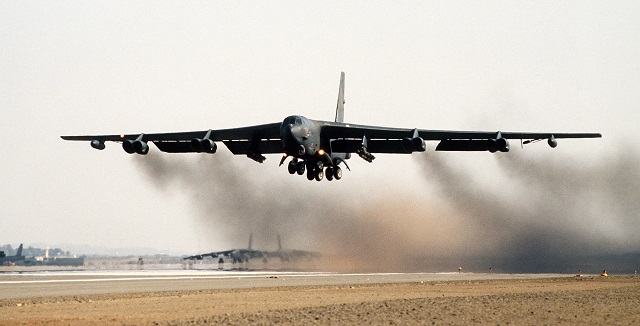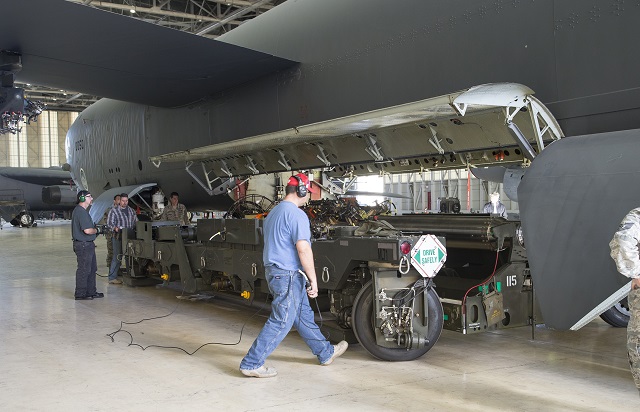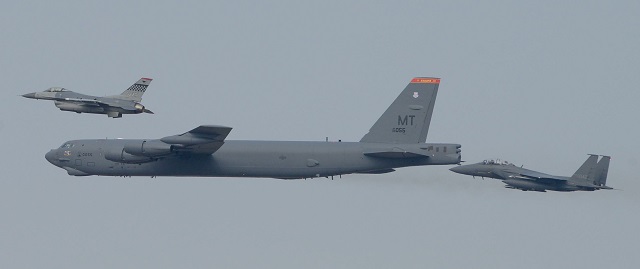On 16 January 1991, seven Boeing B-52Gs fully loaded with AGM-86C conventional air-launched cruise missiles took flight from Barksdale AFB in Louisiana on a top-secret mission to destroy targets inside Iraq.
Those 35h missions were the first combat sorties of Operation Desert Storm. Lesser known is that the mission, dubbed Secret Squirrel, also marked the combat debut of the AGM-86C, with 35 weapons fired and 85-95% of targets successfully destroyed, according to the US air force.
A derivative of the nuclear-tipped AGM-86B, the B-52G would not have been deployed if only armed with nuclear cruise missiles and unguided bombs. Now, 25 years on, Boeing has delivered six modified rotary launchers that will again revolutionise how the veteran B-52 strategic bomber is used in combat.

Boeing B-52G launches in support of Operation Desert Storm
US Air Force
Until now, the slightly newer 1960s H-model aircraft has been unable to drop conventional, precision-guided weapons from its belly. The new digital rotary launcher changes that, by allowing each B-52 to carry eight Boeing-made joint direct attack munitions internally, and eventual extended-range joint air-to-surface standoff missiles (JASSM-ERs) built by Lockheed Martin and Raytheon miniature air-launched decoys.
This means that the B-52 can now carry smart weapons on its wings, and internally – either increasing its destructive power or reducing fuel consumption on long flights by housing weapons internally to reduce drag.
That potent combination of MALD and JASSM-ERs makes the non-stealthy “Stratofortress” a flexible, fist-day-of-war combat aircraft that can destroy targets from hundreds of kilometres away and provide decoy support for flocks of front-line fighter jets. Those six launchers can be swapped between the B-52 fleet.
The upgrade comes as the air force tried to keep its remaining 76 H-model B-52s combat-relevant through 2040 as the classified Northrop Grumman long-range strike bomber (LRS-B) enters service

Upgraded Boeing B-52 rotary launcher
US Air Force
The Stratofortress has long been considered a flying bomb truck, capable of hauling 31.5t (70,000lbs) of ordnance, but its guided weapons capabilities have often lagged more modern airframes.
Last week, the aircraft was sent on a deterrence mission to South Korea as a warning to its northern neighbour, after Pyongyang detonated a nuclear bomb. Going forward, the B-52 will probably feature in more conventional confrontations.

B-52H escorted by US and ROKAF fighter jets
US Air Force
“The upgrades to the B-52 bomber’s internal weapons bay have made it possible to have zero gap on the bomber’s long-range bombing capabilities as we transfer from conventional air-launched cruise missiles to JASSM-ER,” says air force B-52 programme director Col Tim Dickinson.
“With this added capability, the B-52 bomber will remain relevant for decades to come,” adds Boeing B-52 internal weapons bay upgrade manager Jeff Lupton.
Carrying more MALD decoys creates a whole new role for the B-52, because those weapons are designed to replicate the flight path and radar signature of American combat jets to distract air defence systems. The newer version, designated MALD-J, can switch to jamming mode to suppress those same air defences, using a closely-guarded electronic warfare payload.

Raytheon MALD on its first powered flight in 2007

Lockheed JASSM-ER drops from a supersonic Boeing B-1B
US Air Force
Source: FlightGlobal.com
















